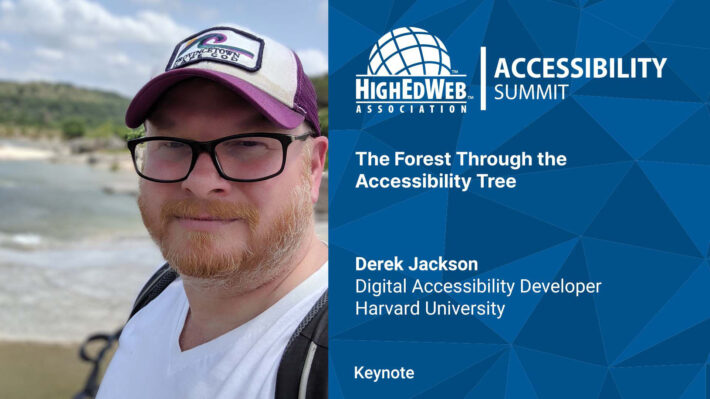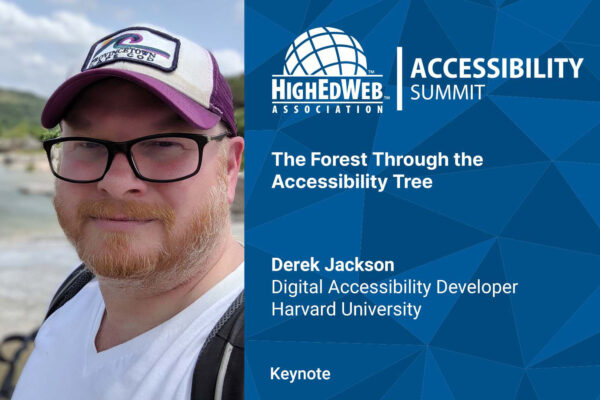Derek Jackson will open the HighEdWeb 2022 Accessibility Summit with a keynote, “The Forest Through the Accessibility Tree.” Link caught up with Jackson — a Digital Accessibility Developer with Digital Accessibility Services at Harvard University — about the focus of his presentation and how technical details can help us understand the larger accessibility picture.

Why are you excited to be the keynote speaker at the Accessibility Summit?
There are a few reasons why I am excited. Personally and professionally, I am thrilled to be a part of it all. This program includes so many great presentations and poster sessions that I look forward to attending. Selfishly, I know I’m going to learn a lot and encounter some wonderful people and ideas at the Summit. I know some of the folks presenting as well — so there are those existing connections, and the excitement of seeing familiar faces — but as the keynote, I’m anticipating getting to know more people who are passionate about the field. Making new connections is such an important part of the work we do.
Also, I’m both excited and a little anxious because this is my first keynote. I feel incredibly honored to have been asked to give the speech by the HighEdWeb Association. For me, it’s something new and exciting that also represents personal growth. Finally, my thinking about disability and digital accessibility has recently evolved a bit, in a way that has energized me in terms of how I view the work we all do to make the web accessible. I’ll talk about that perspective in the keynote, and I hope to impart my enthusiasm and this spirit of growth to the Summit.
In your presentation preview, you mention considering at the technical details to gain a better understanding of the big picture. Could you expand on that?
How much time do we have for this one? I could go on and on, but in a nutshell, I think when we look at the technical details up close, some of the assumptions we’ve made about the web break down. The web is 100% a human-constructed environment; every single part of it is manufactured by us. So there is nothing natural about it, yet the idea that it is natural or that certain of its characteristics are innate has become somehow ubiquitous. When we look closely at the technical details, we start to question those assumptions that we’ve forgotten we’re making — because now we’re really paying attention.
Take the mouse interaction, “point and click,” the interaction everything is seemingly built around. When we examine the technical details and consider the fact that there is just an area on the screen, a section of code, that’s been given some instruction to respond to an interaction from a device, the mouse is no longer a necessity. So why is it a mouse? There’s no technical reason why it needs to be a mouse, and so why not make it available to other devices and subsequently other users? That technical detail reveals it isn’t an issue that stems from a disability, but an issue that stems from the design, which is a “big picture” problem: barriers on the web are an artifact of the web, not the result of a user’s disability.
Once viewers get “a peek under the hood” of the “accessibility tree” technology, what are some concepts about creating accessible content that they might be able to better understand?
I think that depends a bit on what a person’s role is. From an IT perspective, I think it’s powerful to realize how assistive technology works with the browser. So often, developers or QA teams are operating in a “black box” environment, in the sense that what happens between the browser and the assistive technology is a mystery. Understanding that flow of information was a huge, eye-opening moment for me that allowed me to make more thoughtful decisions about development.
Even in a less technical sense, though, knowing that we need to make things programmatically significant, so computers understand what we understand about our content, is something I want people to take away. For instance, why do we make this text bigger? Because it’s a heading, so instead of just changing it to an 18-point font size, we use the heading style so that assistive technology understands explicitly that this is a heading. In design, we can begin to think about making simple and delightful interactions for assistive technology users as well as sighted mouse users. We are just able to make more informed decisions about the content we create when we understand the technology behind it, and that cannot be a bad thing.
If there’s one thing you hope viewers will take away from your keynote, what would it be?
It’s what I alluded to before, that the web is 100% a constructed environment, constructed by people. Because of this, all the prejudice, assumptions, history, bias, privilege and ableism that has been around while the web was being built is going to remain part of it, unless we actively work to change this. Our job is to try and untangle all of that from the web, and the more we understand about it (those technical details, for example), the better equipped we are to confront those issues.
I refer a lot to the social model of disability in the keynote, because I think it applies well to the web as a socially constructed space, but when looking at disability as a whole there is a lot more to take in. I’ve had some fascinating discussions about this with my colleagues, and I’m sure we’ll have more of them at the Summit too. But for me, it really boils down to a human rights issue. Disability presents itself in so many forms, in such a diversity of bodies that change over time. We must recognize disability as a fundamental part of human diversity.
Your bio mentions that you’ve made delivering accessible content a priority in previous roles. What ignited your interest in making sure the content we deliver in higher ed is accessible?
It seems like so many people end up working in this space through some strange and unforeseeable set of circumstances, and I am certainly cut from that cloth myself — if there’s a common thread, it is likely to be that human rights aspect. We are all doing our work, and then one day we learn that somebody, or a lot of people, can’t use the thing we are making, and that is the spark. That’s how it came to me, anyway. My own background is that I have always been a lefty, politically. I went to library school because I feel access to information is an important and fundamental right, I’ve worked with people with disabilities in the past, and I’ve always been a little bit of a techie. So at a previous role, when we had an accessibility review that pointed out that the content we were making was completely inaccessible, that set me off, and little by little I just kept going.
Is there anything you’d like to add?
Come to the HighEdWeb Accessibility Summit! You will not regret it.
Check out a preview of Derek’s presentation and join the online Accessibility Summit on July 28.

